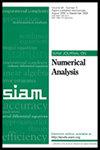广义高斯输入不确定性偏微分方程的拟蒙特卡罗算法
IF 2.9
2区 数学
Q1 MATHEMATICS, APPLIED
引用次数: 0
摘要
SIAM数值分析杂志,第63卷,第4期,1666-1690页,2025年8月。摘要。对具有格弗雷正则输入的参数偏微分方程(PDEs)的不确定性量化的兴趣激增。Gevrey类包含具有高阶偏导数生长条件的无限光滑函数,但通常不是解析函数。Chernov和Lê最近的研究[Comput。数学。达成。, 164(2024),第116-130页;SIAM J. number。分析的。, 62 (2024), pp. 1874-1900]以及Harbrecht, Schmidlin和Schwab[数学。模型、方法、应用。科学。[j], 34 (2024), pp. 881-917]分析假设输入随机场相对于不确定参数是均匀有界的设置。在本文中,我们放宽了这个假设,并允许参数相关的边界。将参数输入建模为广义高斯随机变量,并分析了拟蒙特卡罗积分(QMC)的应用,利用随机移位秩-1格规则来评估PDE响应统计量。除了QMC误差分析外,我们还考虑了尺寸截断和有限元误差。本文章由计算机程序翻译,如有差异,请以英文原文为准。
Quasi-Monte Carlo for Partial Differential Equations with Generalized Gaussian Input Uncertainty
SIAM Journal on Numerical Analysis, Volume 63, Issue 4, Page 1666-1690, August 2025.
Abstract. There has been a surge of interest in uncertainty quantification for parametric partial differential equations (PDEs) with Gevrey regular inputs. The Gevrey class contains functions that are infinitely smooth with a growth condition on the higher-order partial derivatives, but which are nonetheless not analytic in general. Recent studies by Chernov and Lê [Comput. Math. Appl., 164 (2024), pp. 116–130; SIAM J. Numer. Anal., 62 (2024), pp. 1874–1900] as well as Harbrecht, Schmidlin, and Schwab [Math. Models Methods Appl. Sci., 34 (2024), pp. 881–917] analyze the setting wherein the input random field is assumed to be uniformly bounded with respect to the uncertain parameters. In this paper, we relax this assumption and allow for parameter-dependent bounds. The parametric inputs are modeled as generalized Gaussian random variables, and we analyze the application of quasi-Monte Carlo (QMC) integration to assess the PDE response statistics using randomly shifted rank-1 lattice rules. In addition to the QMC error analysis, we also consider the dimension truncation and finite element errors in this setting.
Abstract. There has been a surge of interest in uncertainty quantification for parametric partial differential equations (PDEs) with Gevrey regular inputs. The Gevrey class contains functions that are infinitely smooth with a growth condition on the higher-order partial derivatives, but which are nonetheless not analytic in general. Recent studies by Chernov and Lê [Comput. Math. Appl., 164 (2024), pp. 116–130; SIAM J. Numer. Anal., 62 (2024), pp. 1874–1900] as well as Harbrecht, Schmidlin, and Schwab [Math. Models Methods Appl. Sci., 34 (2024), pp. 881–917] analyze the setting wherein the input random field is assumed to be uniformly bounded with respect to the uncertain parameters. In this paper, we relax this assumption and allow for parameter-dependent bounds. The parametric inputs are modeled as generalized Gaussian random variables, and we analyze the application of quasi-Monte Carlo (QMC) integration to assess the PDE response statistics using randomly shifted rank-1 lattice rules. In addition to the QMC error analysis, we also consider the dimension truncation and finite element errors in this setting.
求助全文
通过发布文献求助,成功后即可免费获取论文全文。
去求助
来源期刊
CiteScore
4.80
自引率
6.90%
发文量
110
审稿时长
4-8 weeks
期刊介绍:
SIAM Journal on Numerical Analysis (SINUM) contains research articles on the development and analysis of numerical methods. Topics include the rigorous study of convergence of algorithms, their accuracy, their stability, and their computational complexity. Also included are results in mathematical analysis that contribute to algorithm analysis, and computational results that demonstrate algorithm behavior and applicability.

 求助内容:
求助内容: 应助结果提醒方式:
应助结果提醒方式:


